The global market for handheld dental x‑ray systems is projected to grow at a healthy pace, rising from USD 241.62 million in 2025 to USD 357.66 million by 2035, reflecting a steady CAGR of 4.0%. In 2024, revenue reached approximately USD 232.0 million, maintaining sector resilience amid rising demand for portable, chairside imaging solutions across private practices, mobile clinics, and outreach programs.
Major innovation was seen in early 2025 when Planmeca introduced its first handheld intraoral x‑ray device, the ProX™ GO, at the IDS exhibition in Cologne. This device features a 0.3 mm focal spot, 70 kV/3 mA tube, and integrated radiation shielding. It was praised for delivering “space‑ and time‑saving chairside efficiency in mobile dental clinics, nursing homes, and emergency situations”. This marks a leap forward in ergonomic design, image quality, and safety for portable dental diagnostics.
In mid‑2024, Mid America Dental Sales launched the X4 Handheld X‑ray, a lightweight 4 lb device powered by a carbon nanotube (CNT) tube. It offers up to 800 images per charge and includes a scatter shield exceeding 0.5 mm lead equivalency. This innovation showcases a trend toward more efficient, operator-friendly unit that maintain performance while enhancing portability and patient comfort.
Regional uptake continues to be led by North America, especially the US, due to widespread adoption across dental practices and institutional investment. Emerging markets like India and China are advancing rapidly, fueled by low-cost device availability and expanding clinic infrastructure. Europe also shows growth, bolstered by mobile and geriatric dental programs.
Looking ahead, the handheld x‑ray systems market appears well‑positioned for sustained growth. Targeted innovations-such as ergonomic form factors, improved tube technologies, onboard safety shields, and enhanced battery performance-are meeting growing demand for flexible, point‑of‑care imaging. With telehealth expansion and at‑home dental services on the rise, portable imaging devices are set to become a standard diagnostic tool through 2035.
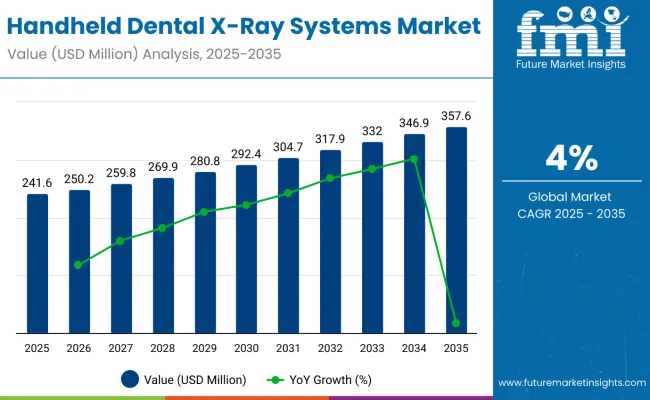
| Attributes | Description |
|---|---|
| Estimated Handheld Dental X-Ray Systems Market Size (2025E) | USD 241.62 Million |
| Projected Handheld Dental X-Ray Systems Market Value (2035F) | USD 357.66 Million |
| Value-based CAGR (2025 to 2035) | 4.0% |
The dental imaging market is evolving rapidly with innovative portable X-ray devices designed to enhance diagnostic accuracy and workflow efficiency. Leading companies like Vatech, Carestream Dental, and OXOS Medical are at the forefront, offering lightweight, wireless, and advanced imaging solutions. These devices feature AI integration, cloud storage, low-radiation technology, and multiple imaging modes, catering to diverse settings such as chairside diagnosis, mobile workflows, and point-of-care environments, improving accessibility and patient care.
Handheld dental X-ray systems are subject to strict government regulations and certification standards to ensure patient safety, radiation protection, and device reliability. Regulatory authorities worldwide oversee the manufacturing, performance, and usage of these devices to comply with health and safety guidelines.
The below table presents the expected CAGR for the global handheld dental x-ray systems market over several semi-annual periods spanning from 2025 to 2035. In the first half (H1) of the decade from 2024 to 2034, the business is predicted to surge at a CAGR of 4.7%, followed by a slightly lower growth rate of 4.4% in the second half (H2) of the same decade.
| Particular | Value CAGR |
|---|---|
| H1 | 4.7% (2024 to 2034) |
| H2 | 4.4% (2024 to 2034) |
| H1 | 4.0% (2025 to 2035) |
| H2 | 3.5% (2025 to 2035) |
Moving into the subsequent period, from H1 2025 to H2 2035, the CAGR is projected to decrease slightly to 4.0% in the first half and decrease moderately at 3.5% in the second half. In the first half (H1) the market witnessed a decrease of 70.00 BPS while in the second half (H2), the market witnessed an increase of 90.00 BPS.
The handheld dental X-ray systems industry is witnessing strong growth due to rising demand for portable imaging and enhanced diagnostic capabilities. In 2025, 201–500 shots systems will dominate with a 50.4% market share, while digital technology will lead the market with a 71% share. Innovations in wireless imaging and real-time diagnostics will drive further market expansion.
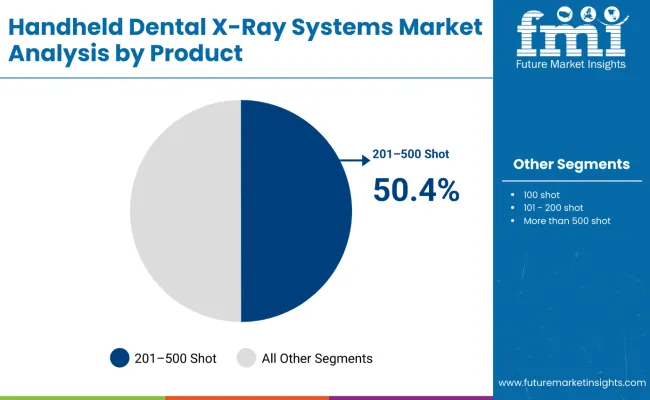
201–500 shots systems are projected to capture a 50.4% market share in the handheld dental X-ray systems market by 2025. Their portability, high battery efficiency, and reliable performance make them the preferred choice in dental practices and mobile clinics. Dentists value these systems for chairside imaging during procedures such as implant placement, endodontic treatments, and orthodontic assessments. The flexibility to perform up to 500 shots per charge enhances clinical productivity and reduces workflow interruptions.
Leading manufacturers like Vatech Co. Ltd., ACTEON Group, Dentsply Sirona, and Carestream Dental are continuously enhancing lightweight designs and battery life in this segment. Additionally, the integration of AI-powered image processing and wireless connectivity further supports clinical efficiency. As demand for point-of-care diagnostics and minimally invasive dental procedures grows, 201–500 shots systems will remain the dominant product segment in this market through 2025.
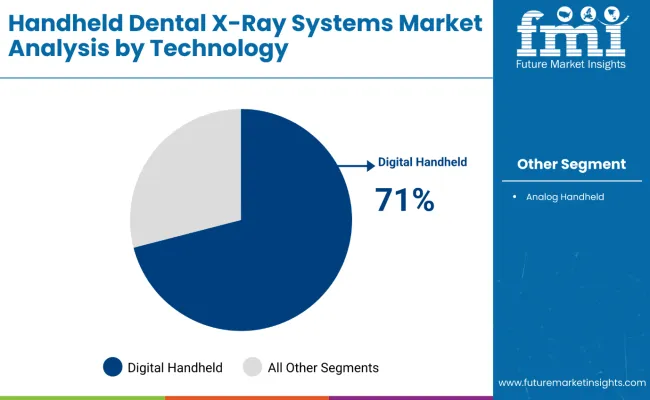
Digital handheld dental X-ray systems are expected to dominate the market with a 71% share by 2025. Their ability to deliver high-resolution images in real time supports faster diagnosis and improved treatment outcomes. Digital systems eliminate the need for film processing, offering instant image viewing and easy integration with dental practice management software. This streamlines workflow and enhances patient experience.
Key players such as Rayence Inc., Vatech Co. Ltd., Carestream Dental, and Dentsply Sirona lead the market with advanced digital imaging platforms. Features such as wireless operation, cloud storage integration, and low-radiation technology further strengthen adoption.
Growing emphasis on radiation safety and the demand for portable, chairside diagnostic tools in dental settings are driving the shift toward digital systems. As digital dentistry continues to evolve, digital handheld X-ray systems will remain central to modern dental imaging solutions through 2025.
The shift from 2D to 3D imaging in the dental industry revolutionizes the capabilities of diagnosis and is expected to propel the growth in the hand-held dental X-ray systems market significantly. With the dental fraternity looking for high-resolution, detailed imaging solutions with more accuracy, the trend of 3D imaging technology is getting more momentum with regard to its better diagnostic benefits over the traditional 2D imaging.
3D imaging provides holistic examination of the patient's oral structures through detailed close attention to teeth, jaws, and tissues surrounding it. On the other hand, 2D imaging offers a plane that often causes blurry or incomplete images, generally leading to misdiagnosis.
For instance, the DEXIS NOMAD Pro 2 is an advanced hand-held dental X-ray system that integrates the latest 3D imaging technology. This device is designed for portability and is particularly popular in mobile dental settings. It features digital radiography capabilities and allows clinicians to take both 3D images.
This trend is shaping the dental sector, as it is transitioning from 2D to 3D with handheld dental X-ray systems. Considering the dental professionals' preference for higher degrees of accuracy and detail in diagnosis, this also predicts an increasing demand for 3D-enabled handheld systems.
As dental professionals increasingly emphasized the comfort, safety, and usability of an instrument, manufacturers have directed their efforts to develop devices that not only deliver advanced diagnostic capability but also offer enhanced ergonomics. Handheld dental X-ray systems have brought portability with ease of use to revolutionize diagnostic procedures, and ergonomic design plays a tremendous role in its adoption.
One of the major characteristics of the ergonomically designed hand-held X-ray system is even weighting to ensure the equipment is easy to hold over a long time.
The manufacturers devise such systems from lightweight materials to make it so light that the system is easily maneuverable, an important factor since this goes to mean the length of time needed to be used and a busy clinical setting. The hand-held dental X-ray systems are inherently designed to ensure high accuracy and control in the procedures.
The Acteon X-Mind Unity is a one-handed dental X-ray unit designed with ergonomic principles in mind for easy handling. It is easy to grip and has a balanced design so that it can be precisely positioned during the procedure and patient monitoring. The device's ergonomic features minimize operator discomfort, making it well-suited for busy clinical use.
The integration of ergonomics into the manufacturing process results in devices that enhance workflow efficiency, reduce physical strain, and improve the overall patient experience. The hand-held dental X-ray systems will keep recording further core ergonomic innovations as key drivers for market expansion due to increasing demand for portable, efficient, and user-friendly diagnostic tools.
Increasing awareness of the risks associated with radiation use among dental professionals highlights a growing need for devices that can mitigate these risks. Associated with this growing awareness about radiation health risks is the implementation of strict guidelines on radiation exposure by regulatory bodies around the world, including the US Food and Drug Administration (FDA) and the International Commission on Radiological Protection (ICRP), in medical and dental devices.
The Genoray PORT-X IV is designed with both lead shielding and scatter-reduction technology to provide high safety standards for operators. The Genoray PORT-X IV is designed with both lead shielding and scatter-reduction technology to provide high safety standards for operators. Its compact, portable design ensures that users are protected from radiation leakage while still delivering sharp, high-resolution images.
Since X-rays are widely used as diagnostic tools during dental procedures, safety against radiation is of paramount importance in dental X-ray equipment. Advances in the technology of scatter reduction and lead shielding are gradually alleviating some of the hazards of radiation exposure, not just from the patient's perspective, but also from the operator's. Safety turns out to be more of an issue with a growing number of portable dental X-ray units.
One of the main reasons for the inefficiency of the market penetration of hand-held dental X-ray systems is the high initial price. Their main benefits in terms of mobility and convenience make them significantly more expensive compared to the more traditional, wall-mounted X-ray systems. High costs may deter small and mid-sized dental clinics as well as underdeveloped region-based practices with extremely limited healthcare budget.
Some factors limit the market penetration of the hand-held dental X-ray systems. These factors include a complicated regulatory environment surrounding these products. Because they emit ionizing radiation, they are often employed at proximity levels close to operators; thus, they pose a significant risk to operator safety.
High standards regarding radiation safety, device performance, and operator protection have been established by regulatory bodies such as the U.S. Food and Drug Administration, the International Commission on Radiological Protection, and regional health authorities.
According to the National Council on Radiation Protection and Measurements (NCRP), dental assistants and technicians who employ handheld systems have raised concerns regarding cumulative radiation exposure, even when advanced technology is used for shielding.
The limited market penetration of hand-held dental X-ray systems poses a significant barrier to their growth. Factors such as high costs, stringent regulatory requirements, and safety concerns among dental professionals and patients contribute to this slow adoption.
The global handheld dental x-ray systems industry recorded a CAGR of 3.0% during the historical period between 2020 and 2024. The growth of handheld dental x-ray systems industry was positive as it reached a value of USD 232.0 million in 2024 from USD 206.1 million in 2020.
The market for handheld dental X-ray systems has undergone remarkable development; it is driven by technological advancement and increasing demand for portable diagnostic equipment. Initially, the performance of dental X-rays was performed using stationary systems, and at the cost of putting patients in fixed settings and limiting flexibility.
This generation's early portable X-ray devices were assumed to be not so reliable on dosing and image quality. However, improvements in radiation shielding, safety devices, and radiography technology saw these through hardships and into acceptance.
Digital handheld X-ray machines eventually replaced film-based systems because they offered higher resolution images, faster processing time, and integration with dental software systems. A change in the aspect of patient care improved workflow efficiency and the outcome of the patients, bringing it to greater market acceptance.
The future of handheld dental X-ray systems is to integrate AI, ergonomic improvement, and wireless connectivity. Tools based on AI are being developed to help the dentist in analyzing images for faster diagnosis with better precision. Improvements in the battery and also use of lighter material for these devices would further lead to more compact and ergonomic devices that offer better handling.
In conclusion, handheld dental X-ray systems will continue to evolve toward safer, more efficient, and more user-friendly solutions. Since technology continues to advance, these systems will be even further integrated into modern dental practices, making diagnoses faster and more accessible for a range of healthcare environments.
Tier 1 companies comprise market leaders with a market revenue of above USD 100 million capturing significant market share of 55.0% in global market. Tier 1 companies focus on expanding their market presence in emerging economies by establishing local manufacturing facilities, distribution networks, and partnerships.
This strategy helps them tap into growing healthcare markets and address local demands more effectively. These companies implement rigorous quality control processes and ensure their products comply with international standards to build trust and credibility in the market. Prominent companies in tier 1 include Envista, VATECH and Carestream Dental LLC.
Tier 2 companies include mid-size players with revenue of USD 50 to 100 million having presence in specific regions and highly influencing the local market and holds around 21.2% market share. Tier 2 companies often specialize in specific segments of the market, such as developing handheld dental x-ray systems for particular types of surgeries or materials.
This targeted approach allows them to become experts in niche areas and cater to specific needs that larger players might overlook. Prominent companies in tier 2 include Acteon, GENORAY, CO., LTD., Posdion Co., Ltd., Dexcowin and REMEDI Inc.
Finally, Tier 3 companies, such as Denterprise Internationals, Digital Doc LLC., Masterlink, LLC., Diagnostic Imaging Systems, Changzhou Sifary Medical Technology Co., Ltd., Flight Dental System, Dentron Systems and Others. These market players specialize in specific products and cater to niche markets, adding diversity to the industry.
Overall, while Tier 1 companies are the primary drivers of the market, Tier 2 and 3 companies also make significant contributions, ensuring the handheld dental X-ray systems sales remains dynamic and competitive.
The section below covers the industry analysis for the handheld dental x-ray systems market for different countries. Market demand analysis on key countries in several regions of the globe, including North America, Asia Pacific, Europe, and others, is provided. The United States is anticipated to remain at the forefront in North America, with higher market share through 2034. In Asia Pacific, India is projected to witness a CAGR of 7.4% by 2035.
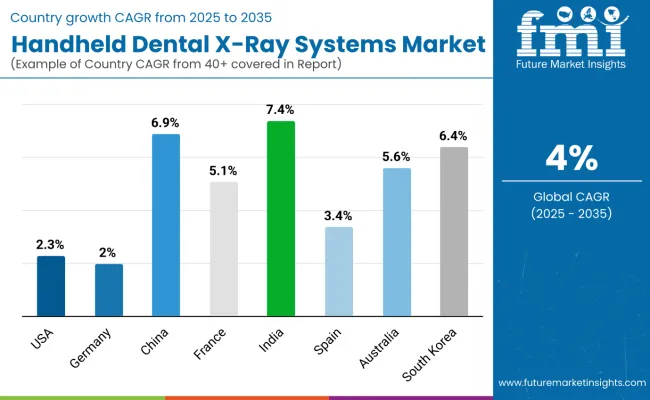
| Countries | Value CAGR (2025 to 2035) |
|---|---|
| USA | 2.3% |
| Germany | 2.0% |
| China | 6.9% |
| France | 5.1% |
| India | 7.4% |
| Spain | 3.4% |
| Australia | 5.6% |
| South Korea | 6.4% |
China handheld dental x-ray systems market is poised to exhibit a CAGR of 6.9% between 2025 and 2035. Currently, it holds the highest share in the East Asia market, and the trend is expected to continue during the forecast period.
The low costs of production methods in China, combined with lower labor costs, contribute to the affordable cost of handheld dental x-ray systems. This cost advantage will enable Chinese manufacturers to quote competitive prices in both the domestic and international markets, thereby attracting healthcare providers and distributors.
China has been able to corner a strong share in the global handheld dental x-ray systems export market by leveraging the advantage brought in by its manufactural prowess to supply healthcare providers across the globe. This reach has given impetus to China's position in the international handheld dental x-ray systems market.
Backed by fast infrastructure development in the Chinese healthcare industry, such as building new hospitals and surgical centers, handheld dental x-ray systems have kept up their rapid growth. This growing market opens ample opportunities for local manufacturers to supply their products.
United States handheld dental x-ray systems market is poised to exhibit a CAGR of 2.3% between 2025 and 2035. Currently, it holds the highest share in the North America market, and the trend is expected to continue during the forecast period.
Improved healthcare infrastructure, especially across the emerging economies, has drastically improved access to surgical procedures and consequently raised demand for handheld dental x-ray systems. More hospitals, dental clinics, and better-equipped systems of healthcare have placed handheld dental X-ray systems within the reach of healthcare professionals.
With enhanced healthcare standards globally, there will be a continuous demand for the highest quality imaging modalities, including handheld dental x-ray systems. The increasing demand is due to the requirement of precision, safety, and efficiency in medical diagnostics.
Handheld dental X-ray systems manufacturers view this as a challenge and substantially invest in research and development activities to come out with new products meeting the emerging requirements of health institutions
Rigorous regulatory approvals in the case of medical devices are expected to serve as a barrier in the adoption of new technologies associated with handheld dental x-ray systems, hence delaying their launch in the market.
India’s handheld dental x-ray systems market is poised to exhibit a CAGR of 7.4% between 2025 and 2035. Currently, it holds the highest share in the Asia Pacific market, and the trend is expected to continue during the forecast period.
Rising dental diseases in India continues to push up demand in handheld dental X-ray systems. Low oral hygiene, a rising consumption of sweet food items, tobacco usage, and a lack of awareness about oral care are few of the main reasons that cause conditions like cavities, gum disease, and oral infections to reach alarming levels.
Recent studies show that the states of children and adults in India suffer extensively from dental caries, with 60% of the population being affected by some dental disease in India.
There is a growing trend in volumes of dental patients, thus making the need for efficient diagnostic tools increase. Handheld dental X-ray systems have several benefits that entitle them as devices to use in and out of the clinic: it is portable, easy to use, and brings faster imaging, which enables the dentist to give faster diagnosis and treatment in an urban or rural area, hence making India a prominent player in the market.
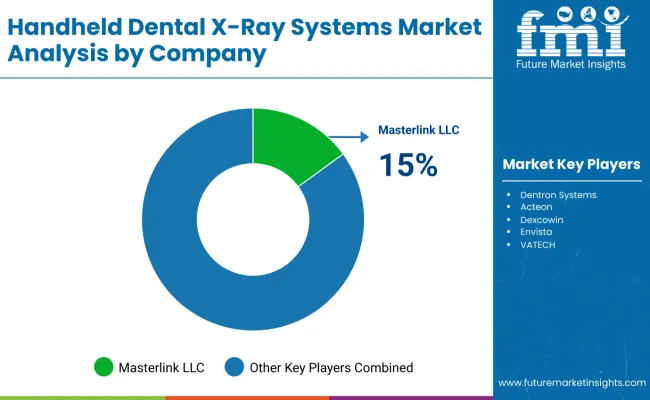
The market players are using strategies to stay competitive, such as product differentiation through innovative formulations, strategic partnerships with healthcare providers for distribution. Another key strategic focus of these companies is to actively look for strategic partners to bolster their product portfolios and expand their global market presence.
| Report Attributes | Details |
|---|---|
| Market Size (2025) | USD 241.62 Million |
| Projected Market Size (2035) | USD 357.66 Million |
| CAGR (2025 to 2035) | 4.0% |
| Base Year for Estimation | 2024 |
| Historical Period | 2020 to 2024 |
| Projections Period | 2025 to 2035 |
| Quantitative Units | USD million for value and thousand units for volume |
| Products Analyzed (Segment 1) | Up to 100 Shots System, 101 - 200 Shots System, 201 - 500 Shots System, More than 500 Shots |
| Technologies Analyzed (Segment 2) | Digital, Analog |
| End Users Analyzed (Segment 3) | Hospitals, Independent Dental Clinics, Group Dental Practices, Ambulatory Surgical Centers, Academic & Research Centers |
| Regions Covered | North America; Latin America; Western Europe; Eastern Europe; South Asia & Pacific; East Asia; Middle East & Africa |
| Countries Covered | United States, Canada, Brazil, Mexico, Germany, France, United Kingdom, Italy, Spain, China, India, Japan, South Korea, Australia, GCC Countries, South Africa |
| Key Players influencing the Handheld Dental X-Ray Systems Market | Envista, VATECH, Diagnostic Imaging Systems, Flight Dental System, Masterlink LLC, Dentron Systems, Acteon, Dexcowin, Carestream Dental LLC, GENORAY CO., LTD., Others |
| Additional Attributes | Market size in dollar sales and CAGR, share by product type (intraoral, extraoral), application trends (diagnostics, surgery), end-user demand (clinics, hospitals), regional dollar sales, competitive dollar sales, portability trends, regulatory landscape, tech innovations. |
In terms of product, the industry is divided into upto 100 shots system, 101 - 200 shots system, 201 - 500 shots system and more than 500 shots.
In terms of type, the industry is segregated into digital and analog.
In terms of application, the industry is segregated into hospitals, independent dental clinics, group dental practices, ambulatory surgical centers and academic & research centers.
Key countries of North America, Latin America, Western Europe, Eastern Europe, South Asia & Pacific, East Asia and Middle East and Africa (MEA) have been covered in the report.
The global handheld dental x-ray systems market is projected to witness CAGR of 4.0% between 2025 and 2035.
The global handheld dental x-ray systems industry stood at USD 232.0 million in 2024.
The global handheld dental x-ray systems market is anticipated to reach USD 357.66 million by 2035 end.
India is set to record the highest CAGR of 7.4% in the assessment period.
The key players operating in the global Handheld Dental X-Ray Systems Market include Envista, VATECH, Diagnostic Imaging Systems, Flight Dental System, Masterlink, LLC., Dentron Systems, Acteon, Dexcowin, Carestream Dental LLC., GENORAY, CO., LTD., Posdion Co., Ltd., Digital Doc LLC., REMEDI Inc., Changzhou Sifary Medical Technology Co., Ltd. and Denterprise Internationals.






Our Research Products

The "Full Research Suite" delivers actionable market intel, deep dives on markets or technologies, so clients act faster, cut risk, and unlock growth.

The Leaderboard benchmarks and ranks top vendors, classifying them as Established Leaders, Leading Challengers, or Disruptors & Challengers.

Locates where complements amplify value and substitutes erode it, forecasting net impact by horizon

We deliver granular, decision-grade intel: market sizing, 5-year forecasts, pricing, adoption, usage, revenue, and operational KPIs—plus competitor tracking, regulation, and value chains—across 60 countries broadly.

Spot the shifts before they hit your P&L. We track inflection points, adoption curves, pricing moves, and ecosystem plays to show where demand is heading, why it is changing, and what to do next across high-growth markets and disruptive tech

Real-time reads of user behavior. We track shifting priorities, perceptions of today’s and next-gen services, and provider experience, then pace how fast tech moves from trial to adoption, blending buyer, consumer, and channel inputs with social signals (#WhySwitch, #UX).

Partner with our analyst team to build a custom report designed around your business priorities. From analysing market trends to assessing competitors or crafting bespoke datasets, we tailor insights to your needs.
Supplier Intelligence
Discovery & Profiling
Capacity & Footprint
Performance & Risk
Compliance & Governance
Commercial Readiness
Who Supplies Whom
Scorecards & Shortlists
Playbooks & Docs
Category Intelligence
Definition & Scope
Demand & Use Cases
Cost Drivers
Market Structure
Supply Chain Map
Trade & Policy
Operating Norms
Deliverables
Buyer Intelligence
Account Basics
Spend & Scope
Procurement Model
Vendor Requirements
Terms & Policies
Entry Strategy
Pain Points & Triggers
Outputs
Pricing Analysis
Benchmarks
Trends
Should-Cost
Indexation
Landed Cost
Commercial Terms
Deliverables
Brand Analysis
Positioning & Value Prop
Share & Presence
Customer Evidence
Go-to-Market
Digital & Reputation
Compliance & Trust
KPIs & Gaps
Outputs
Full Research Suite comprises of:
Market outlook & trends analysis
Interviews & case studies
Strategic recommendations
Vendor profiles & capabilities analysis
5-year forecasts
8 regions and 60+ country-level data splits
Market segment data splits
12 months of continuous data updates
DELIVERED AS:
PDF EXCEL ONLINE
Dental X-Ray Systems Market Analysis - Size, Share, and Forecast Outlook 2025 to 2035
Dental Matrix Systems Market Size and Share Forecast Outlook 2025 to 2035
Dental Suction Systems Market Size and Share Forecast Outlook 2025 to 2035
Handheld Imaging Systems Market Size and Share Forecast Outlook 2025 to 2035
Dental Anesthesia Delivery Systems Market
Dental Repair Membranes for Implant Procedures Market Size and Share Forecast Outlook 2025 to 2035
Dental Cavity Filling Materials Market Size and Share Forecast Outlook 2025 to 2035
Handheld Electrostatic Meter Market Size and Share Forecast Outlook 2025 to 2035
Handheld Ultrasound Scanner Market Size and Share Forecast Outlook 2025 to 2035
Dental Implant and Prosthetic Market Size and Share Forecast Outlook 2025 to 2035
Handheld Tagging Gun Market Forecast and Outlook 2025 to 2035
Dental Imaging Equipment Market Forecast and Outlook 2025 to 2035
Dental Wounds Treatment Market Size and Share Forecast Outlook 2025 to 2035
Dental Radiometer Market Size and Share Forecast Outlook 2025 to 2035
Dental Anaesthetic Market Size and Share Forecast Outlook 2025 to 2035
Dental Diamond Bur Market Size and Share Forecast Outlook 2025 to 2035
Dental Laboratory Market Size and Share Forecast Outlook 2025 to 2035
Handheld XRF Analyzers Market Size and Share Forecast Outlook 2025 to 2035
Handheld Police Radar Guns Market Size and Share Forecast Outlook 2025 to 2035
Handheld DNA Reader Market Size and Share Forecast Outlook 2025 to 2035

Thank you!
You will receive an email from our Business Development Manager. Please be sure to check your SPAM/JUNK folder too.
Chat With
MaRIA